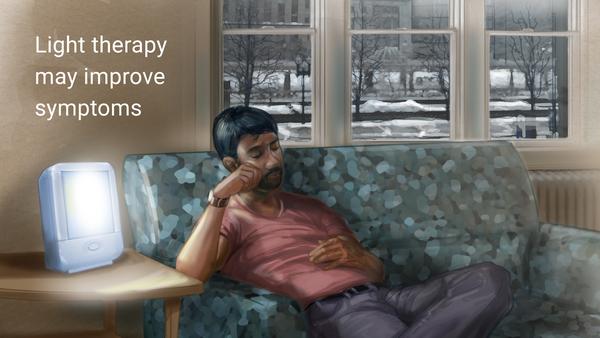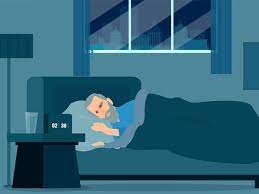SAD: Seasonal Affective Disorder
Seasonal Affective Disorder (SAD) is a type of depression that occurs at a specific time of year, typically during the fall and winter months when daylight hours are shorter. This condition can have a significant impact on an individual’s mood, energy levels, and overall well-being.
Common symptoms of SAD include feelings of sadness, hopelessness, fatigue, and difficulty concentrating. Many people also experience changes in appetite, weight gain, and a lack of interest in activities they once enjoyed. The lack of sunlight during the winter months is believed to play a role in the development of SAD, as it can disrupt the body’s internal clock and affect the production of certain hormones that regulate mood.
It’s important for individuals experiencing symptoms of SAD to seek help from a healthcare professional. Treatment options for SAD may include light therapy, where individuals are exposed to bright artificial light to mimic natural sunlight and regulate their circadian rhythms. Counseling, medication, and lifestyle changes such as regular exercise and maintaining a healthy diet can also be beneficial in managing SAD.
If you or someone you know is struggling with symptoms of SAD, remember that you are not alone. With proper support and treatment, it is possible to effectively manage this condition and improve your quality of life during the darker months of the year.
7 Positive Aspects of Understanding Seasonal Affective Disorder: From Awareness to Action
- Increased awareness of mental health issues
- Opportunity for individuals to seek help and support
- Encourages self-care practices and healthy lifestyle changes
- Highlighting the importance of sunlight exposure for overall well-being
- Promotes discussions about the impact of seasonal changes on mental health
- Raises awareness about the significance of circadian rhythms in mood regulation
- Opens up conversations about different treatment options and coping strategies
7 Challenges of Seasonal Affective Disorder: Understanding Its Impact on Daily Life
- Decreased energy levels
- Feelings of sadness and hopelessness
- Difficulty concentrating on tasks
- Changes in appetite leading to weight gain
- Loss of interest in activities once enjoyed
- Disruption of sleep patterns and quality of sleep
- Impact on social relationships and daily functioning
Increased awareness of mental health issues
Seasonal Affective Disorder (SAD) brings about an important pro by increasing awareness of mental health issues. As individuals experience the effects of SAD during the fall and winter months, it sheds light on the significance of mental well-being and the impact that environmental factors can have on our mood and overall mental health. This heightened awareness can lead to more open conversations about mental health, increased support for those experiencing SAD or other mental health conditions, and a greater emphasis on self-care practices to maintain good mental health throughout the year.
Opportunity for individuals to seek help and support
Seasonal Affective Disorder (SAD) presents a unique pro by providing individuals with an opportunity to seek help and support for their mental health. The recognition of SAD symptoms during the fall and winter months can prompt individuals to reach out to healthcare professionals, therapists, or support groups for assistance. This proactive approach allows individuals to address their emotional well-being, explore treatment options such as light therapy or counseling, and develop coping strategies to manage the challenges associated with SAD. Seeking help and support not only promotes self-care and mental wellness but also reinforces the importance of reaching out for assistance when needed.
Encourages self-care practices and healthy lifestyle changes
Seasonal Affective Disorder (SAD) can serve as a catalyst for encouraging individuals to prioritize self-care practices and make healthy lifestyle changes. The awareness of the impact of reduced sunlight on mood and energy levels can motivate people to adopt strategies such as regular exercise, proper nutrition, and adequate sleep to support their mental well-being. By recognizing the importance of self-care in managing SAD symptoms, individuals are empowered to take proactive steps towards improving their overall health and resilience during the challenging winter months.
Highlighting the importance of sunlight exposure for overall well-being
Sunlight exposure plays a crucial role in maintaining our overall well-being, and this importance is particularly highlighted in the context of Seasonal Affective Disorder (SAD). Natural sunlight is essential for regulating our circadian rhythms, boosting vitamin D production, and influencing the production of serotonin, a neurotransmitter that contributes to feelings of happiness and well-being. For individuals experiencing SAD, ensuring adequate sunlight exposure can help alleviate symptoms such as low mood, fatigue, and sleep disturbances. Incorporating strategies to increase sunlight exposure, such as spending time outdoors during daylight hours or using light therapy devices, can positively impact mental health and contribute to an improved sense of well-being.
Promotes discussions about the impact of seasonal changes on mental health
Seasonal Affective Disorder (SAD) serves as a catalyst for important discussions surrounding the influence of seasonal changes on mental health. By shedding light on how varying levels of sunlight can significantly impact mood and well-being, SAD prompts individuals and healthcare professionals to recognize the profound effects of environmental factors on mental health. This increased awareness fosters conversations about proactive strategies for coping with seasonal fluctuations and emphasizes the importance of seeking support and implementing self-care practices during challenging times of the year.
Raises awareness about the significance of circadian rhythms in mood regulation
Seasonal Affective Disorder (SAD) serves as a pro by raising awareness about the importance of circadian rhythms in regulating mood. The link between daylight exposure, hormone production, and our internal body clock becomes more evident through the manifestation of SAD symptoms during the darker months. By highlighting this connection, SAD emphasizes the crucial role that light and darkness play in influencing our emotional well-being and underscores the need to prioritize factors like exposure to natural light and maintaining a healthy sleep-wake cycle for overall mental health.
Opens up conversations about different treatment options and coping strategies
Seasonal Affective Disorder (SAD) can have a silver lining in that it opens up conversations about different treatment options and coping strategies. When individuals are affected by SAD, it prompts discussions about light therapy, counseling, medication, lifestyle changes, and other interventions that can help alleviate symptoms and improve well-being. By raising awareness about various approaches to managing SAD, individuals can explore different avenues for support and find the most effective strategies that work for them. This pro of SAD encourages a proactive approach to mental health and fosters a sense of empowerment in seeking the right tools to cope with seasonal mood changes.
Decreased energy levels
One significant con of Seasonal Affective Disorder (SAD) is the decrease in energy levels that individuals often experience. During the fall and winter months when daylight is limited, people with SAD may struggle to find the motivation and vitality to engage in daily activities. This lack of energy can impact productivity, social interactions, and overall quality of life, making it challenging to maintain a sense of normalcy and well-being. It is important for those affected by SAD to seek appropriate treatment and support to address this decrease in energy levels and regain a sense of vitality during the darker seasons.
Feelings of sadness and hopelessness
One significant con of Seasonal Affective Disorder (SAD) is the overwhelming feelings of sadness and hopelessness that individuals may experience during the fall and winter months. These emotions can be debilitating, making it challenging for people to engage in daily activities, maintain relationships, and find joy in life. The persistent sense of despair can affect one’s overall mental well-being and quality of life, highlighting the importance of seeking appropriate treatment and support to address these negative emotions effectively.
Difficulty concentrating on tasks
One significant challenge associated with Seasonal Affective Disorder (SAD) is the difficulty in concentrating on tasks. Individuals affected by SAD may find it hard to focus, make decisions, or complete everyday activities due to the impact of this condition on their cognitive functions. The decrease in sunlight during the fall and winter months can disrupt the body’s internal clock and hormonal balance, contributing to cognitive difficulties experienced by those with SAD. This symptom can interfere with work performance, academic achievement, and overall productivity, highlighting the importance of seeking appropriate treatment and support to manage the cognitive effects of SAD effectively.
Changes in appetite leading to weight gain
One common con of Seasonal Affective Disorder (SAD) is the changes in appetite that can lead to weight gain. Individuals affected by SAD may experience an increase in cravings for high-calorie comfort foods, particularly those rich in carbohydrates and fats. This change in eating habits, coupled with decreased physical activity levels due to low energy and motivation, can contribute to unwanted weight gain over the fall and winter months. Managing these fluctuations in appetite and weight can be challenging for individuals dealing with SAD, impacting both their physical health and self-esteem.
Loss of interest in activities once enjoyed
One significant con of Seasonal Affective Disorder (SAD) is the loss of interest in activities once enjoyed. Individuals affected by SAD may find themselves disengaged from hobbies, social interactions, and other activities that previously brought them joy and fulfillment. This lack of interest can further exacerbate feelings of sadness and isolation, making it challenging to maintain a sense of connection and engagement with the world around them. It is crucial for those experiencing this symptom to seek support and treatment to help reignite their passion for life and rediscover the activities that bring them happiness.
Disruption of sleep patterns and quality of sleep
Seasonal Affective Disorder (SAD) can lead to a disruption of sleep patterns and a decrease in the quality of sleep experienced by individuals affected by this condition. The reduced exposure to natural light during the fall and winter months can disrupt the body’s circadian rhythm, making it more difficult to fall asleep and stay asleep throughout the night. This can result in feelings of fatigue, irritability, and difficulty concentrating during the day, impacting overall productivity and well-being. Addressing these sleep disturbances is crucial in effectively managing SAD and improving one’s mental health during the darker seasons.
Impact on social relationships and daily functioning
Seasonal Affective Disorder (SAD) can have a significant con in its impact on social relationships and daily functioning. Individuals experiencing SAD may find it challenging to engage in social activities, maintain relationships, or fulfill daily responsibilities due to feelings of sadness, fatigue, and lack of motivation. This can lead to isolation, strain on personal connections, and difficulties in meeting work or academic obligations. The negative effects of SAD on social interactions and daily functioning highlight the importance of seeking support and implementing coping strategies to navigate through this challenging period effectively.



